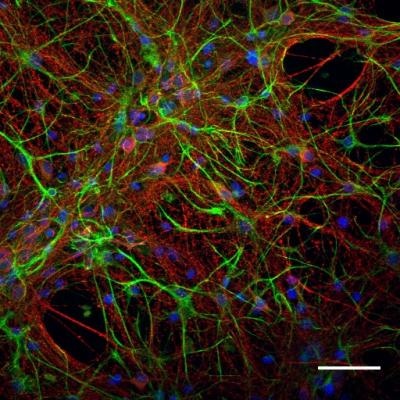Aug 5 2019
Carbon nanotubes, designed into self-standing novel materials through certain chemical alterations, are capable of modulating the activity of nerve cells. These materials could possibly be exploited for repairing damaged nerve tissues.
 Hybrid networks of neurons and self-standing nanotubes (confocal micrograph) [Image credit: Rossana Rauti]
Hybrid networks of neurons and self-standing nanotubes (confocal micrograph) [Image credit: Rossana Rauti]
Due to a unique chemical treatment—known as crosslinking—carbon nanotubes are capable of taking on the required shapes, and they can simultaneously function as substrata to promote the growth of nerve cells, finely adjusting their activity and growth.
The study, a joint work between SISSA (Scuola Internazionale Superiore di Studi Avanzati) and the University of Trieste, has been recently reported in the journal ACS Nano—the renowned international scientific journal.
The study represents a new, significant step towards the development of neuronal regenerative-interfaces to heal spinal injuries.
The research is the latest achievement of a long-term and—in terms of outcomes—effective association between the researchers Maurizio Prato of the University of Trieste and Laura Ballerini of SISSA. In addition, the team has been helped by CIC biomaGUNE of San Sebastián, Spain.
Self-Standing Nanotubes
Appropriate chemical treatments were used to modify the carbon nanotubes utilized in the study.
For many years, in our laboratories we have been working on the chemical reactivity of carbon nanotubes, a fascinating but very difficult material to work. Thanks to our experience, we have crosslinked them or, to say it more clearly, we have treated the nanotubes so they could link themselves to one another thanks to specific chemical reactions. We have discovered that this procedure gives the material very interesting characteristics.
Maurizio Prato, Professor, University of Trieste
Professor Prato added, “for example, the material organises itself in a stable manner according to a precise shape, we choose: a tissue where nerve cells need to be planted, for example. Or around some electrodes. We know from previous research that nerve cells grow well on carbon nanotubes so they could be used as a surface to build hybrid devices to regenerate nerve tissues.”
“It was necessary to ensure that this chemical modification did not compromise this process and study whether the interaction with neurons was altered,” he further stated.
Towards Biosynthetic Hybrids
Professor Ballerini continued, “We have discovered that the chemical process has important effects because through this treatment we can modulate the activity of neurons, in terms of growth, adhesion and survival. These materials can also regulate the communication between neurons. We can say that the carpet of cross-linked carbon nanotubes interacts intensely and constructively with the nerve cells.”
Such an interaction relies on the extent at which the different carbon nanotubes are connected to one another, or rather cross-linked. The link number among the nanotubes is inversely proportional to the activity of neurons growing on their surface.
The neurons’ response can be regulated via the chemical control of their characteristics, and of the links between them.
Ballerini and Prato explained, “this is an intriguing result that emerges from the important and fruitful collaboration between our research groups involving advanced research in chemistry, nanoscienc, and neurobiology. This study provides a further step in the design of future biosynthetic hybrids to recover injured nerve tissues functions.”